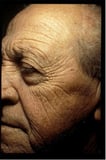What Layer(S) Of The Skin Are Blood Vessels Found Within?
The pare is the torso'southward largest organ. It serves many important functions, including
-
Protecting the body against trauma
-
Regulating torso temperature
-
Maintaining water and electrolyte balance
-
Sensing painful and pleasant stimuli
The peel has three layers:
-
Epidermis
-
Dermis
-
Fat layer (as well called the subcutaneous layer)
Each layer performs specific tasks.
Getting Under the Pare
The peel has three layers. Beneath the surface of the pare are nerves, nervus endings, glands, hair follicles, and blood vessels. Sweat is produced by glands in the dermis and reaches the surface of the skin through tiny ducts.
The epidermis is the relatively thin, tough, outer layer of the skin. Most of the cells in the epidermis are keratinocytes. They originate from cells in the deepest layer of the epidermis chosen the basal layer. New keratinocytes slowly migrate up toward the surface of the epidermis. In one case the keratinocytes achieve the skin surface, they are gradually shed and are replaced by newer cells pushed up from beneath.
The outermost portion of the epidermis, known every bit the stratum corneum, is relatively waterproof and, when undamaged, prevents most bacteria, viruses, and other foreign substances from entering the body. The epidermis (forth with other layers of the skin) also protects the internal organs, muscles, fretfulness, and blood vessels from injury. In certain areas of the body that require greater protection, such equally the palms of the hands and the soles of the feet, the stratum corneum is much thicker.
Scattered throughout the basal layer of the epidermis are cells called melanocytes, which produce the pigment melanin, 1 of the main contributors to peel color. Melanin's main function, however, is to filter out ultraviolet radiation from sunlight (meet Overview of Sunlight and Skin Damage Overview of Sunlight and Skin Damage Sunlight stimulates vitamin D production, helps control some chronic skin diseases (such every bit psoriasis), and causes a sense of well-existence. However, sunlight can cause skin damage. Damage includes... read more  ), which damages Deoxyribonucleic acid, resulting in numerous harmful furnishings, including skin cancer Overview of Peel Cancer Skin cancer is the most common type of cancer. Skin cancer is about common among people who piece of work or play sports outside and among sunbathers. Blanched people are peculiarly susceptible... read more than .
), which damages Deoxyribonucleic acid, resulting in numerous harmful furnishings, including skin cancer Overview of Peel Cancer Skin cancer is the most common type of cancer. Skin cancer is about common among people who piece of work or play sports outside and among sunbathers. Blanched people are peculiarly susceptible... read more than .
The epidermis also contains Langerhans cells, which are role of the skin's immune system. Although these cells help notice foreign substances and defend the body against infection, they besides play a role in the development of skin allergies.
The dermis, the skin's adjacent layer, is a thick layer of fibrous and rubberband tissue (fabricated mostly of collagen, with a small but important component of elastin) that gives the skin its flexibility and force. The dermis contains nervus endings, sweat glands and oil glands (sebaceous glands), hair follicles, and blood vessels.
The nerve endings sense hurting, touch, pressure, and temperature. Some areas of the skin contain more nerve endings than others. For example, the fingertips and toes contain many nerves and are extremely sensitive to touch.
The sweat glands produce sweat in response to oestrus and stress. Sweat is equanimous of water, common salt, and other chemicals. Every bit sweat evaporates off the peel, it helps cool the body. Specialized sweat glands in the armpits and the genital region (apocrine sweat glands) secrete a thick, oily sweat that produces a characteristic body aroma when the sweat is digested by the skin bacteria in those areas.
The sebaceous glands secrete sebum into pilus follicles. Sebum is an oil that keeps the skin moist and soft and acts as a barrier against strange substances.
The pilus follicles produce the various types of hair found throughout the body. Hair not only contributes to a person's appearance but has a number of important physical roles, including regulating body temperature, providing protection from injury, and enhancing sensation. A portion of the follicle likewise contains stalk cells capable of regrowing damaged epidermis.
The blood vessels of the dermis provide nutrients to the skin and help regulate body temperature. Heat makes the blood vessels enlarge (dilate), allowing large amounts of blood to circulate nigh the peel surface, where the estrus can be released. Common cold makes the blood vessels narrow (tuck), retaining the body'south heat.
Over different parts of the trunk, the number of nerve endings, sweat glands and sebaceous glands, hair follicles, and blood vessels varies. The top of the head, for example, has many hair follicles, whereas the soles of the feet accept none.
Below the dermis lies a layer of fat that helps insulate the body from heat and cold, provides protective padding, and serves every bit an energy storage area. The fat is contained in living cells, called fatty cells, held together by fibrous tissue. The fat layer varies in thickness, from a fraction of an inch on the eyelids to several inches on the abdomen and buttocks in some people.
Source: https://www.msdmanuals.com/home/skin-disorders/biology-of-the-skin/structure-and-function-of-the-skin
Posted by: hartmanblide1962.blogspot.com


0 Response to "What Layer(S) Of The Skin Are Blood Vessels Found Within?"
Post a Comment